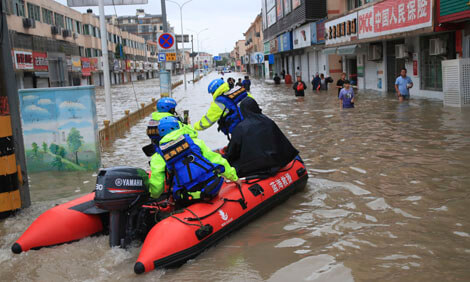


People wade through flooded streets in Zhengzhou, China.
Climate scientists have been raising alarms about global warming for years. Average temperatures on Earth have risen about 2°F since the late 1800s. Most of this temperature rise has happened in the last 40 years. In fact, the last four years (2016–2020) have seen the highest average temperatures ever recorded. While global warming is a natural trend, most scientists believe that human activity—particularly the burning of fossil fuels—has accelerated global warming to unnatural levels.
One of the main effects of this acceleration in warming has been an increase in extreme weather. So far this year, places in the United States and around the world have experienced deadly heat, massive wildfires, and epic floods.
In late June 2021, high temperatures enveloped parts of the United States and Canada. Scientists blame this extreme heat on a weather phenomenon called a heat dome. A heat dome forms when air currents stop or stall hot ocean air. These air currents shifted north, creating conditions for a heat dome in the Northwest and western Canada.
In Portland, Oregon, temperatures reached a blistering 116°F. The high temperature for Portland in June is normally 73°F. Nearly 200 Americans and 500 Canadians died from the extreme heat. Heat domes in these northern areas are rare. But, they have occurred in the past. Many climate scientists believe that the intensity of this heat dome, though, would not have been possible without global warming.
Another effect of an increase in average temperatures in some regions is the threat of wildfires. Hot, dry conditions have contributed to massive wildfires around the world. In mid-July, there were more than 80 large wildfires in the western United States. One of the largest is the Bootleg fire in Oregon. This wildfire is the size of the city of Los Angeles. Siberia in Russia—a region famous for its extreme cold—is also battling massive wildfires that cover more than one million acres. In fact, due to unusually hot temperatures, much of Russia is under threat of wildfires.
While some regions of the world burn, others have experienced flooding on an epic scale. In general, warmer temperatures bring more moisture to the atmosphere. This, in turn, causes more storms that are more intense. In mid-July, storms brought what would normally be two months of rainfall in just two days to parts of Germany. Rivers swelled and burst their banks, flooding towns and farmland. More than 200 people were killed in the flooding.
Record-breaking rainfall in China has also led to devastating flooding. Storms dropped about a year’s worth of rainfall in just three days in Henan Province. The flooding that resulted forced more than one million people from their homes. More than 90 people lost their lives. Among those were 14 people trapped in a flooded subway in Zhengzhou, the capital city.
Climate scientists had expected an increase in extreme weather. However, many have been surprised by the frequency and intensity of the events experienced so far in 2021. As extreme weather continues to batter regions around the world, it is becoming clear that more action to combat climate change and global warming is needed, and soon.



























